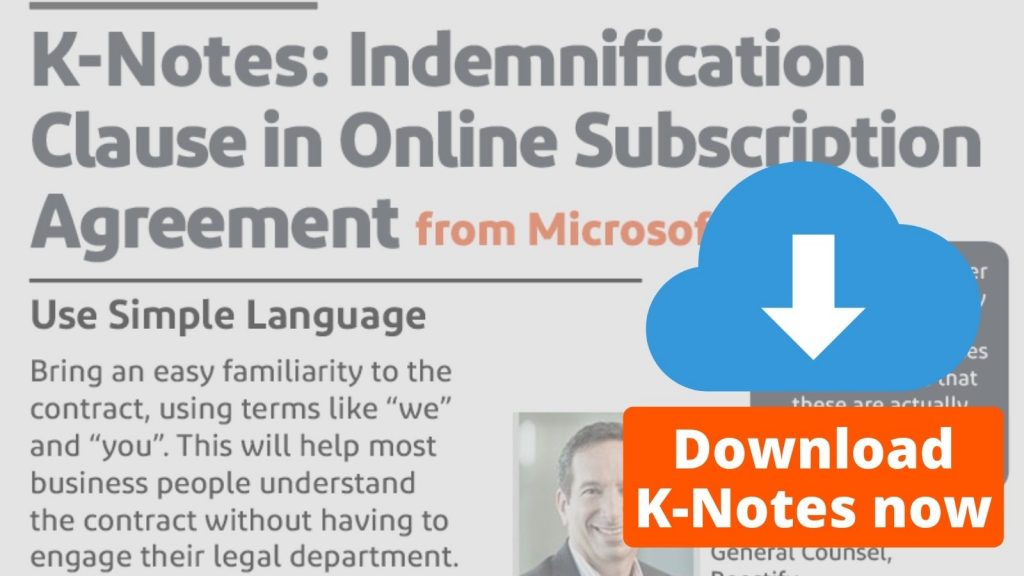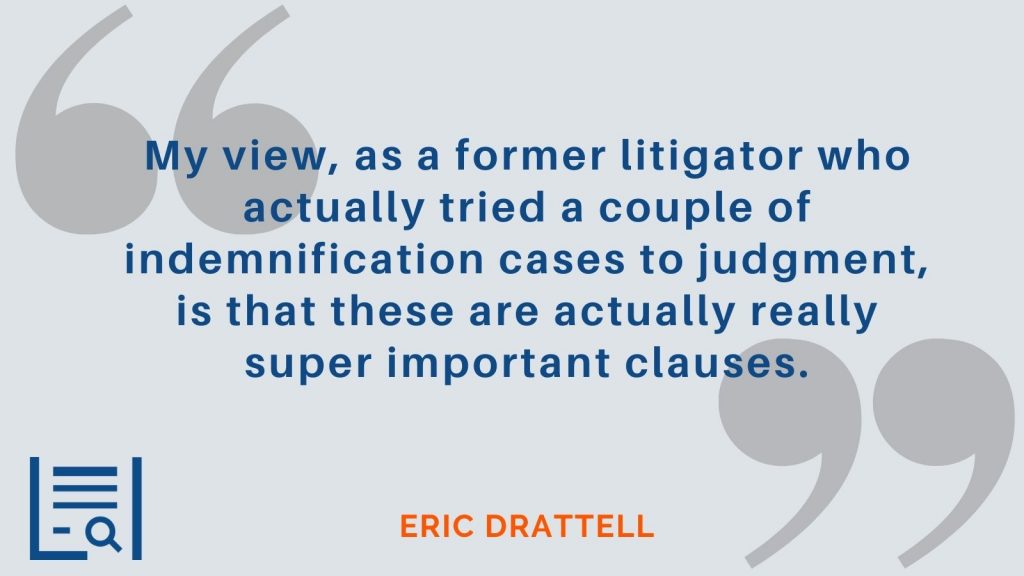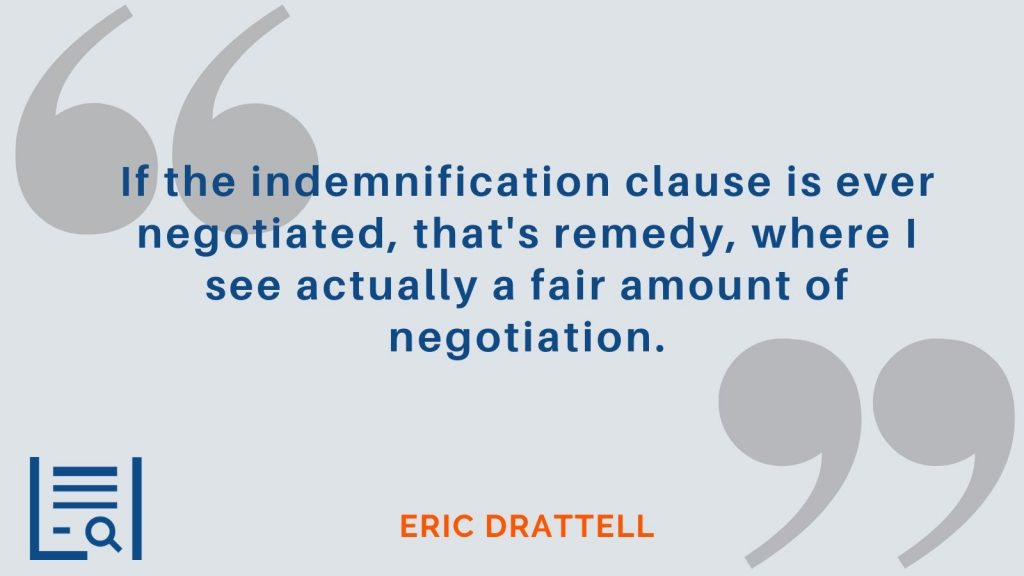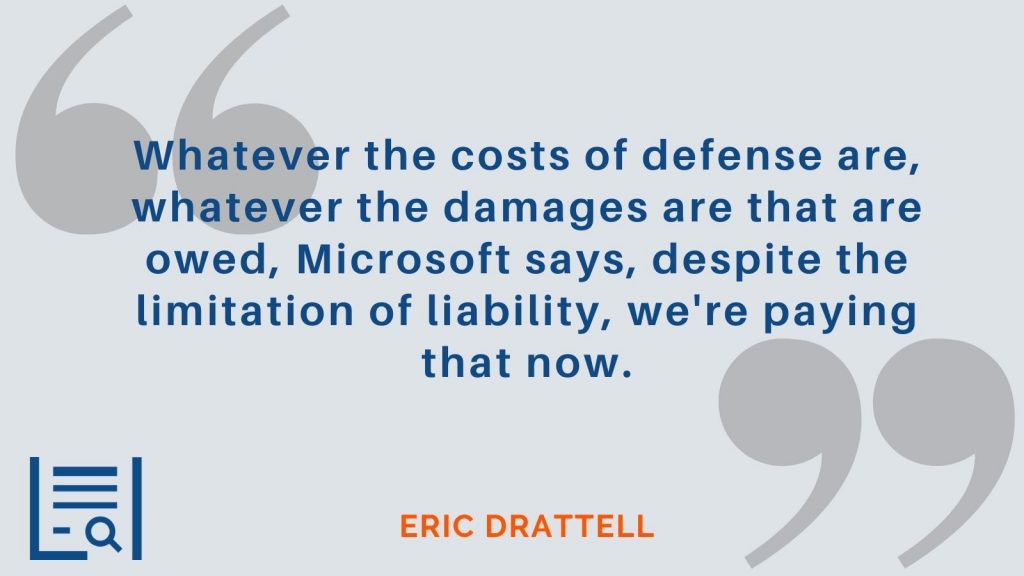Indemnification clauses are important but often overlooked parts of most contracts. Eric Drattell, general counsel at Roostify, tears down Microsoft’s indemnification clause in their Online Subscription Agreement. He explains how contract drafters can use these principles to avoid getting tied up in lengthy litigation and how to keep their client’s company afloat when IP issues are at stake.
Questions in this Episode
- Why use simpler contract language?
- What’s the difference between indemnify and defend?
- How are state indemnity laws different?
- Which remedy causes the most problems?
- Should you warranty and indemnify against infringement?
Are Indemnification Clauses Important?
Almost every contract has an indemnification clause. But, many lawyers insert them “pro forma” without understanding what they are asking for or why. When he is negotiating a contract, he says he often gets back the indemnification clause with no red-line changes as if the other party never read it.
The Microsoft agreement is a tech license agreement, and attorney Drattell discusses many tech-specific issues. However, these indemnification clause principles are equally applicable to other businesses, like construction and service businesses.
Simpler Contract Language
Many companies are trying to make their contract language easier to understand, as does Microsoft in this document.
Besides making it easier to read and comprehend, by making the language simpler, there is less opportunity to argue about ambiguity in the contract. For example, Microsoft refers to themselves as “we” and the licensee as “you.” Attorney Drattell believes this easy familiarity makes this a very readable contract.
It is also a fairly short document, only about ten pages compared to the regular twenty-plus pages of other similar agreements that do not fundamentally say anything more than Microsoft’s shorter one.
Defense of Claims Versus Indemnification
Section 5 is titled “Defense of Claim” and not “Indemnification.”
Below, Attorney Dratell discusses why he likes how this section is titled and the language and terms.
But first, the contract drafter must be familiar with the differences between “indemnifying” and “defending.”
Contract drafters use defense and indemnity clauses to shift potential risk from one party to the other. While these two terms often appear in the same paragraph, they are not the same and impose different duties on the parties.
“Indemnification” usually means that one party will pay or compensate the other party for certain legal losses described in the agreement. Typically this payment comes after the other party has a judgment entered against it, or paid, or suffered an actual loss.
The term “Defend” usually imposes a duty on the other party to actively defend the other party for claims brought against them that are within the scope of the agreement.
State Indemnity Laws are Not All the Same
Unfortunately, the difference between “defend” and “indemnify” is not clear-cut in every state. Different states have different indemnity laws. Attorney Drattell explains that in some states an indemnity agreement will carry the duty to defend, even though the contract doesn’t specifically say so.
| a. |
Defense |
| (i) We will defend you against any claims made by an unaffiliated third party that a Product infringes that third party’s patent, copyright or trademark or makes unlawful use of its trade secret.
(ii) You will defend us against any claims made by an unaffiliated third party that (1) any Customer Data, Customer Solution, or Non-Microsoft Products, or services you provide, directly or indirectly, in using a Product infringes the third party’s patent, copyright, or trademark or makes unlawful use of its trade secret; or (2) arises from violation of the Acceptable Use Policy. |
|
| c. |
Remedies |
| If we reasonably believe that a claim under Section 5.a.(i). may bar your use of the Product, we will seek to: (i) obtain the right for you to keep using it; or (ii) modify or replace it with a functional equivalent and notify you to stop use of the prior version of the Product. If these options are not commercially reasonable, we may terminate your rights to use the Product and then refund any advance payments for unused Subscription rights. |
In Section 5.a. Microsoft agrees to “defend” the licensee. And under Section 5.c. if Microsoft defends the licensee, Microsoft agrees to “reimburse the other for reasonable out-of-pocket expenses” and “pay the amount of any resulting adverse final judgment or settlement.”
In effect, Microsoft agrees to defend and indemnify the licensee, within the scope of the agreement.
Why Does Microsoft Want to Defend the Licensee?
Microsoft agrees to defend the licensee in a third-party IP infringement claim. But, why?
A licensee has no incentive to defend the claim. On the other hand, Microsoft owns the IP and has a substantial monetary interest in defending the paternity of its intellectual property. By defending, Microsoft gets to control the process.
But When Does Microsoft Defend?
The agreement says that the indemnifying party, most likely Microsoft, can either defend as the claim is brought or wait until the resolution of the claim to defend.
Most licensees do not have the financial resources for this type of legal battle. They want Microsoft to defend the claim from the beginning, as costs incur. Otherwise, they have to front all the legal expenses out of pocket.
An essential point for the licensee to know is that Microsoft can choose when to defend the claim, depending on governing state law. If you are a small licensee, Microsoft has all the power. They can defend from the beginning, or wait until a judgment is entered.
Defend Against Whom and for What?
Attorney Drattell says that about half of the indemnification clauses he looks at allow for the parties to indemnify against each other and third parties. He believes that Microsoft’s approach is more appropriate, stating that the defense and indemnification are for third-party claims only.
More importantly, Microsoft has qualifying language that third parties must be “unaffiliated,” meaning that a licensee or subsidiary of yours cannot bring a claim.
So, Microsoft agrees to defend the licensee against patent, copyright, or trademark infringement claims made by an unaffiliated third party.
Two Main Limitations
Attorney Drattell believes the Limitation section is relatively standard but is “pretty good draftsmanship.” Microsoft will not indemnify you if a third party brings a claim due to your modification or combination.
If you modify a Microsoft product, the indemnification won’t apply to the extent that the claim is based on the modifications. And, if you and Microsoft both have products that do not infringe when they stand alone, Microsoft will not indemnify you if the combination of those two products causes an infringement.
This is referred to as the repair, replace or refund remedy.... The repair piece is not objectionable. It's the refund piece that creates a problem. #ContractTeardown Click To Tweet
Remedies
Attorney Drattell refers to the remedies in the agreement as the “repair, replace, or refund” remedy.
Repair. If the product breaks, Microsoft will fix it so you can continue to use it. Or, Microsoft might pay a third-party license fee so you can continue to use it.
Replace. Microsoft might swap out the infringing product for a non-infringing product.
Refund. If it is commercially reasonable to do so, Microsoft might repair or replace the product. But, if all fails, Microsoft might just refund your money.
Most problems and objections come with the refund. The licensee’s business might rely on that particular product. If Microsoft decides to exit that product and give the licensee a refund, that is a pretty hollow remedy. But also, some of these infringement cases can take months or years. Attorney Drattell had one infringement case that took five years from the initial claim until he got to court. With such a lengthy process, the licensee probably has lots of notice as to whether there’s indemnification or if they are getting a refund.
Tender the Defense
If Microsoft is going to defend a third-party claim, the licensee must give control of the case to Microsoft by tendering the defense to them. The parties agree that the defense should be promptly tendered to the other party, but the agreement does not specify the timing of that action.
Should I tender the defense now or do I wait till I'm sued? #ContractTeardown Click To Tweet
Attorney Drattell likes the reimbursement language of this section from a licensee’s perspective. The agreement states that reasonable out-of-pocket expenses will be reimbursed. Agreements are often silent on this issue. Also, this section states that the defending party will pay judgments and settlements. This language is upfront, and Microsoft is saying to the licensee, “We will pay you.”
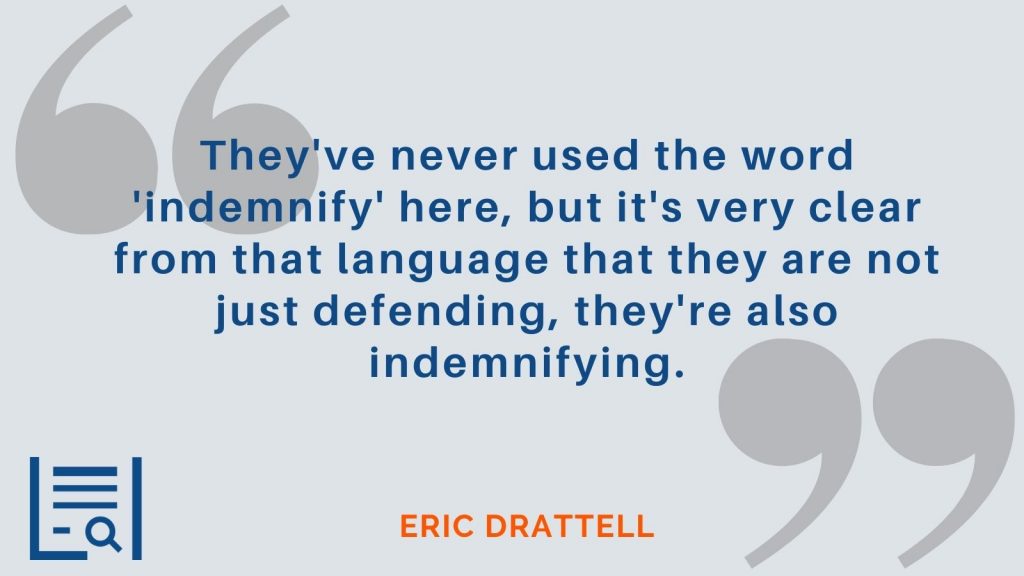
Limitation and the Indemnity Exception
At first glance, the limitation of liability section seems standard and possibly even low for the licensee – but Microsoft has an exception that helps the Licensee.
There is a relatively common limit to direct damages of fees paid 12 months before the claim. And for free products, Microsoft limits their liability to $5,000, which attorney Drattell believes is generous for a free product.
But defense and indemnity amounts are an exception to the liability limits. Attorney Dratell believes this is well written and says the cap on liability does not apply to indemnification claims.
Warranty versus Indemnification
Microsoft has also done a good job with its contract language in the Warranty section. Unlike this agreement, many sloppy contract drafters put in a warranty of non-infringement and an indemnification against infringement claims. The licensee should be entitled to one remedy, not two.
Also, the licensor wants the remedy to be straightforward. Poor drafting will potentially give you two different claims. The limitation of liability would cap the warranty claim, and there would be no obligation to tender the defense. The defense of claim and indemnification allows the licensor to guard the paternity of its IP and is not capped by the liability limits. In drafting a contract like this, attorney Drattell would steer his client toward the indemnification approach.
Making A Good Agreement Even Better
Attorney Dratell likes the Microsoft Online Subscription Agreement, and the indemnification clause, from the perspective of both the licensee and licensor.
Below are some highlights of good contract drafting used by Microsoft, along with suggestions to make a good agreement even better.
Good
- The contract drafting trend of many modern companies is to use simple, easy-to-read, easy-to-understand language. Microsoft brings an easy familiarity to the agreement using terms like “we” and “you” instead of Microsoft and Licensee along with simple straightforward language.
- Microsoft defends and indemnifies while retaining control of when and how to do so to protect their IP and be more in control.
- Microsoft chose to cap its liability but made an exception for indemnification and reimbursement of expenses and judgments, which helps the licensee.
Even Better
- One improvement could be if Microsoft agreed to defend costs as they incurred, instead of the option of waiting until the end.
- Giving a more precise definition of a claim would bring more clarity. Is a threatened claim considered a claim? For example, if a third party claims IP ownership and sends a cease and desist letter, or other threatening letters, is this subject to indemnification? Should you tender the defense right then or wait until you are sued? Attorney Drattell has received such letters in the past and tendered the defense right away, and no one ever said it was too soon.
This is a well-written contract and something that most business people could understand without having to engage the legal department to parse the terms for them. And the indemnification clause makes sense for both sides.
Show Notes
THE CONTRACT: Microsoft Online Subscription Agreement
THE GUEST: Eric Drattel is a senior legal and compliance leader with expertise in privacy (US and EU), tech transactions, licensing, cloud/SaaS computing, and mentoring. You can find him on LinkedIn, or email him at Roostify (edrattell@roostify.com).
THE HOST: Mike Whelan is the author of Lawyer Forward: Finding Your Place in the Future of Law and host of the Lawyer Forward community. Learn more about his work for attorneys at www.lawyerforward.com.
If you are interested in being a guest on Contract Teardown, please email us at community@lawinsider.com.
Transcript
Eric Drattell [00:00:00] What I am negotiating a contract is quite often that the verification clause doesn’t even even seem to be read. So I get very few red lines back on it. But my view as a former litigator is to actually try a couple of indemnification cases to judgment. These are actually really superfluous clauses.
Intro Voice [00:00:19] Welcome to the Contract Teardown show from Law Insider, where legal experts tear down contracts from some of the most well-known companies and high profile executives around the world.
Mike Whelan [00:00:31] In this episode, Eric Drattell, general counsel at Roostify, tears down Microsoft’s online subscription agreement. He gets into the indemnification clause and the other sections that might undermine it. We talk about using clear language, making sure you don’t get tied up in long winded litigation and staying afloat when IP is at stake. This is a great breakdown of one of the most potentially contentious sections of an agreement. So let’s tear it down.
Mike Whelan [00:00:58] Hey, everybody, welcome to the Contract Teardown Show. I’m Mike Whalen, hanging out with smart friends like this guy, Eric Drattell. Eric, how are you today?
Eric Drattell [00:01:08] Mike? I’m doing very well, thank you.
Mike Whelan [00:01:10] it’s still twenty twenty. So what the freak. for today, guys, we are going to share a document with you and tear it down. It is this one, it is the Microsoft online subscription agreement. And specifically we’re going to go down to the indemnification clauses which are found in a section called Defense of Claims. So, Eric, here’s what I want you to do to start us off. Tell me why this section matters. When are we going to see it? Why should lawyers care?
Eric Drattell [00:01:38] So you’ll see an indemnification clause in almost every contract. And I think lawyers tend to insert them just as a pro forma matter without oftentimes understanding what it is they’re asking for or why they’re even asking for it. And what I am negotiating a contract, it’s quite often that the indemnification clause doesn’t even even seem to be read. So I get very few red lights back on it. But my view as a former litigator is who actually tried a couple of indemnification cases to judgment. These are actually really super important clauses, both from the sellers or licensors perspective and the buyers the licensees perspective. The closer we’re going to talk about today is in the Microsoft agreement, which is a tech license agreement. So we’ll talk about a lot of things that are applicable to tech license contracts agreements. But all of them are really equally applicable to a construction contract, a service contract. All all the same principles really apply.
Mike Whelan [00:02:38] Well, we’ll start we’re going to go through the different language, but we’re going to start with just the title of this document. I found this document for a legal document, surprisingly easy to read the fact that they called this a defensive claims. So if you guys are looking at the document, it’s down in five defensive claims versus using the language that’s common. Does that strike you? It just struck me as interesting
Eric Drattell [00:03:02] and it does strike me as interesting because a number of companies have endeavored to make contract language simpler. And by making it simpler, you have less of an opportunity to argue about whether this ambiguity in a contract. So, for example, Microsoft refers to themselves as we they refer to the licensee as you. And it’s that kind of easy familiarity, I think makes this a very easily readable contract. It’s also a fairly short contract, relatively speaking. I looked at others in preparing for our show today, and there were some that were, you know, twenty plus pages long. And it didn’t fundamentally say anything more than what Microsoft says.
Mike Whelan [00:03:45] Yeah, so this one’s about ten pages and we’re going to start with that defensive claims. It is still a legal document so we can still pass the language under a it says defense. It says we being Microsoft will defend you being the licensee against any claims made by an unaffiliated third party that a product infringes that third parties patent copyright or trademark or makes unlawful use of its trade secret. We like this. We don’t like this. What do you think?
Eric Drattell [00:04:13] I like this actually very much. Although we can we can talk about past the aspects of it. So first of all, why is Microsoft offering this? And when you look at this, what Microsoft really wants to do is defend the paternity of its IP. So if a third party makes an IP infringement claim, the licensee has absolutely no incentive to to defend that. Right. And what Microsoft is really the one with the incentive to defend and you’ll see sprinkled throughout this is language very similar to that which shows the intent of Microsoft to defend the paternity at the IP. So that’s pretty important. Now, Microsoft says we will defend and it depends on the state you’re in. If you say that, I will indemnify you. Some states in. ID automatically includes defense. Other states defense is a completely different obligation. So what Microsoft is saying here essentially is they will defend, but they’re also going to say they’re saying they’ll indemnify as well later using different words, but meaning the same thing. So it’s pretty important that Microsoft will defend. Now, an important point here to note, again, depending on the state law that governs excuse me, the indemnifying party, Microsoft in this instance can either defend as the claim is brought, or wait until the resolution of the claim to defend. And so if you’re a small licensee, Microsoft’s got all the power. You don’t what you especially if you don’t have the financial resources, what you want is the defense to be with when the costs are incurred for defense. So you oftentimes see language saying we will defend you for these various claims has incurred. And I think that’s a pretty important point from a licencees perspective that you want to have the defense of the claim as incurred. So that’s that’s pretty important. Next part here is unaffiliated third parties. Now, I would say half the indemnification clauses I look at have that language or don’t get in some states, oddly, you can have indemnification between the contracting parties for claims one brings against the other. And that’s never made any sense to me. I think it’s more appropriate that the indemnification be for third party claims and the fact that what Microsoft is doing here is qualifying that to say unaffiliated third parties is important, saying that a subsidiary of yours or a licensee of yours perhaps can’t bring a claim, but a third party who asserts ownership of the IP rights could bring that claim. So that’s that’s that’s important language. And then what Microsoft says is that will it will indemnified defend you for any claims that that patent rights are infringed? Now, I’ve been practicing law for, let’s say, how long? It’s been a long time. And when I first started practicing law, we were always told one hundred percent of the time, never indemnify for patent infringement. And that’s because in the US at the time, the law was the first to invent the patent, went to the first to invent as opposed to the first to file, which is like the rest of the world. However, US patent laws changed over the last few years, and now US is also a first to file jurisdiction as opposed to a first jurisdiction. So if it was a first to invent jurisdiction, somebody could sit on their patent rights, not do anything, see Microsoft’s come up with something and file. Meanwhile, Microsoft would have indemnified for that claim that they could have done a patent search and found a clean patent and just kind of blindly stumbled into an indemnification claim. But now, let’s say the last 20 years or so, it’s pretty common for the the licensed store to indemnify for patent infringement. And again, it goes back to protecting the paternity of the IP.
Mike Whelan [00:08:16] Yeah, it sounds like they’re using pretty modern language to talk about. You know, this is a pretty updated contract. It doesn’t sound very copy paste. They do go over some licensee obligations right after that. But let’s jump down to the limitations, because I think it puts the constraints on this thing. You know, they say our obligations in five will not apply to a claim or award based on any customer solution, customer data, non Microsoft products, or your combination of the product with or damages based upon the value of customer data or non Microsoft. So if you’re blending three, your use of Microsoft trademark without our consent and then also your redistribution. And it talks a bit about free products. So they put a lot of constraints on this thing. Are these is this the right way to format this to you?
Eric Drattell [00:09:02] Yeah, yeah. This is this is actually pretty standard. If you make modifications to a Microsoft product, Microsoft is actually saying that they’re indemnification won’t apply to the extent that the claim is based on the modifications. So if you’ve modified something and the modification causes the claim, then you don’t get indemnification for that. And the same thing with what’s referred to in two is used in combination. If if a Microsoft product standing alone doesn’t indemnify, rather doesn’t infringe and your product standing alone doesn’t infringe, but the two together infringe, then to the extent that combination caused the claim, then Microsoft to say we’re not indemnify you for that. It doesn’t really corner cases. You typically don’t see that very often that something like that actually happens in the real world. But nonetheless, it’s pretty good draftsmanship. To have the language in there like that,
Mike Whelan [00:10:02] yeah, I like jumping down to remedies in see some of these qualifications they put on what they’ll do for you. It says that if you get this claim under five that make it so you can’t use the product, we Microsoft will seek to obtain the right for you to keep using it or modify or replace it with an equivalent. If it’s not commercially reasonable, we might just terminate the rights to use the product and then return any advance fees. That sounds like a pretty nice remedy to have in there.
Eric Drattell [00:10:33] So that’s that’s an interesting one. That’s one. If if the indemnification clause is ever negotiated, that’s where I see actually a fair amount of negotiation. This is referred to as repair replace for fund remedy. So I’ll either. Fix it so you can continue to use it, I’ll pay the the third party a license fee so you can continue to use it. That’s the repair. I’ll replace it. I’ll swap out something that is not infringing with with something that some swap out the infringing product for a non infringing product, or if all else fails, if it’s not commercially reasonable to do otherwise, that I’ll just I’ll just refund your money. That’s where a lot of people have an issue on that refund piece. The repair place is not objectionable. It’s the refund piece that creates a problem. So I’m relying on the Microsoft product or Microsoft simply wants to choose to exit that product and refund my money. That’s oftentimes a pretty hollow remedy. But because of the way patent claims in particular IP infringement claims tend to go, they go on forever. And it’s very common. When an infringement claim is brought, it can take months for even the the the accused party that in this case, Microsoft, to even determine whether there’s a valid infringement or not. So you’ve probably, as the licensee, had a lot of notice as to whether there’s indemnification or not or whether you’re going to get a refund or not. And so oftentimes what I’ll see is some I think it’s somewhat uninformed. Licensees will say that within 30 days you have to make the remedy available, which is absurd because, again, it’s going to take a year to 18 months for Microsoft to do all the things it would do to determine whether there’s an infringement or not. So 30 days is way too short period of time. And then the refund piece is also potentially challenging.
Mike Whelan [00:12:33] And it sounds, you know, as you mentioned, the length of time that it takes to sort these things out. If you look indeed under obligations, you know, they point out that you’ve got to give the other side so sole control over the defense and the settlement. And then you’ve got to help in defending the claim. And then it talks about the party providing the protection will reimburse the other party for out of pocket expenses and pay the amount of the final judgment or settlement. You know, you made the point this could take years.
Eric Drattell [00:13:02] That’s right. That’s right. One of the indemnification cases I litigated, I believe, went about five years from the time of the claim till we finally got to court. So that’s not that’s not uncommon to happen.
Mike Whelan [00:13:17] So when you shift these obligations to for some kind of interim support while that’s happening.
Eric Drattell [00:13:23] Well, as long as they’re not yanking the product out from under now, I think that this is perfectly appropriate. And what I’m looking for as a licensee, what Microsoft is offering, I think, is both commercially reasonable and something that actually works for both of us quite well. So it’s not something I would typically want to negotiate. And then, as you’ve already referred to, the obligations, indeed, the what? The obligation to tender the defense, that’s pretty, pretty standard. It says you have to notify the other promptly of a claim. Again, the law in some states is that you oftentimes see it in an indemnification clause, the obligation to within 10 days, 15 days, 30 days tendered the defense of the claim. And and you’ll also see language that says and if you don’t tend to the defense within the time provided, then our obligation is waived, first of all, that I’ve never seen anybody’s obligation ever get away because again, as the licenser, you want to defend the paternity of your IP, therefore. If you’re if it’s on the 16th day and you said you had attended the defense in 15 days, you’re not going to I’m not liable any longer. So that’s that doesn’t make any sense. And they didn’t get some states failure to timely tendered. The defense only reduces the amount of the indemnification by the extent to which the indemnifying party is prejudiced by the late tendering of the defense. So let’s play this scenario out. If I’m with Mike, if you’re the licenser and I’m the licensee and I get a claim and I spend a year defending that claim and make some careless admissions and things like that that make it harder for you to defend the claim than the chances are that whatever damages I’m entitled to, whatever indemnification I’m entitled to, would be reduced by the amount that, for example, I made admissions that that caused the the damages to go up. So it’s to the extent that you were prejudiced by my untimely tendering of the defense of the claim is what you will usually provide you with some sort of Microsoft, interestingly, doesn’t use that language here. They just say you have to promptly tender the defense. So I think that that’s quite common. Giving the sole control again is very often the case. One thing you will see from time to time is the indemnified party will have a right to appoint counsel of its own as counsel or to to oversee or whatever, but at my expense, the indemnified parties expense and and we have no right to make admissions or do anything. It’s just really tough to monitor the status of the case. You see that every so often, especially in a high stakes indemnification claims. But I don’t I don’t think that’s it’s it’s the language here, again, is quite common. And then one things that’s in here that I really like from a licencees perspective is reimburse the licensee for out of pocket, reasonable, out of pocket expenses. Oftentimes the agreement is silent on that or I’ve seen some. In fact, I’ve looked at one even recently, which says that the indemnified party has to pay for its own costs of helping the endowment of the indemnified party. And I said that. Right. That doesn’t apply. Yes, the indemnifying party has to pay its own expenses of cooperating with the indemnified party. So this is pretty good. This is pretty upfront and says that we will pay you. And and so it’s all the right language. Remember earlier I mentioned in that first paragraph and five a talked about the cost of defense. So here’s now where they say in to where they will pay the amount of any any judgment. So that’s that’s the indemnification piece. Again, they’ve never used the word indemnify here, but it’s it’s it’s very clear from that language that they are not just defending, but they’re also indemnifies.
Mike Whelan [00:17:32] Well, I want to talk about the relationship of a couple of other sections with the indemnification piece. And the first is the limitation. This is down in six and it talks about the aggregate liability of each party for all claims. Under this agreement, it’s limited to direct damages to the amount paid under this agreement for the online service during the twelve months before the cause of action provided that in no event the aggregate liability for any online service exceed the amount paid for that online service during the subscription than it talks about for free products. That’s capped at five thousand. How I mean this that seems like a low number relative to what this claim could become.
Eric Drattell [00:18:12] It’s it certainly would be, but for an exception, they’ve created. So the language here is, again, fairly common that that there’s a limitation of liability. Twelve months fees. It’s a very standard amount that you cap liability at that they’re even throwing at five thousand dollars for free product is, relatively speaking, generous. Five thousand doesn’t sound like much, but when it’s free, standing up for the product is still pretty good. But what they do is they say that the limitations of liability do not apply to claims under a party’s obligations under Section five, the defense of claims or indemnification clause. This is this is really well written. This is saying that. So the cap on liability does not apply. The exclusion of damages doesn’t apply to indemnification claims. So whatever the cost of defense are, whatever the damages are that are owed, Microsoft say, despite the limitation of liability, we’re paying that now. This is one that I do see also negotiated fairly often. And sometimes it’s because of really terrible drafting. So sometimes you’ll see in exceptions to limitations provision, something along the lines of except for breaches of confidence. Reality or indemnification, right? So a breach of an indemnification clause, so if if somebody is really passing the contract and you get a judge who or jury that’s reading just the literal words of the contract, the only time the exclusion would apply in that case is if there was a breach of the indemnification clause. That’s not what you’re looking for. The exclusion for what you’re looking for. The exclusion for is the obligations under the indemnification clause. So what Microsoft has done here is exactly what I would be looking for, saying that require a breach first. But to say that the parties obligations under Section five give an exception and and the the damages are potentially uncapped. Well, what I this is also often negotiated because I do see from time to time in not typically in an IP infringement indemnification, but indemnification for other types of things where somebody will want to put a cap. So as an example, there are a lot of contracts today that involve the processing of data for third party. You and I enter into a contract. You give me your customers data to to process. If I have a data breach, what’s my obligation to indemnify you in that instance? It’s a very common clause you see in a lot of contracts these days. And so if there were a data breach and I’m processing your data, the liability could be in the tens of millions of dollars for a very low value contract. So as the as the processing party is the party who ultimately would bear that potentially that liability, I would not typically want to see the indemnification capped at some multiple perhaps of the the fees paid. So it might be five times or 10 times fees paid. But the indemnification exclusion here in the Microsoft agreement, as it applies to the the the IP license is perfectly appropriate and one that would, in my view, past that objection.
Mike Whelan [00:21:50] Well, before we talk, you know, sort of the general principle from this, in closing, I want to give you a chance to talk about the relationship between this section and the warranty section, which is back and forth. We won’t read it. But but give me your thoughts on the you know, the fact that we’ve got both indemnification and warranties. Does that tell you anything?
Eric Drattell [00:22:07] Yes. So Microsoft, again, has done a good job here. What a lot of drafters do, and I think it’s somewhat sloppy, is they both want a warranty of non infringement and indemnification. And in my view, you you really should be entitled to one remedy not two. So this is this is oftentimes coming from the licensee. The licensee says, I want you to warrant not infringement, and I also want an indemnity for non infringement. So it’s potentially two different claims. The warranty claim would be capped by the limitation of liability, whereas the indemnification would not. And as the licenser, I want it clear where the licensee’s remedy lies, because under the warranty clause, if the licensee is going to make a warranty claim, there’s no obligation to tender the defense and all the things that as the license or protect the license or enables the license or to guard the paternity of the IP, whereas under the ID, all of that is there. So as the licenser, I will say to the customer, you pick one remedy, you get one, not both. And I try to steer them to the indemnification because it’s not capped by the limitation of liability. And I would say in most cases, not all, but most deem the one the licensee understands that they’re getting a better remedy under the indemnification clause. They really don’t need that that warranty of not infringement. It’s it’s something that’s been in lots of clauses for years and years. Nobody pays any attention to it. And I think it’s actually worthwhile paying attention to. So I, I would exclude it and go into the indemnification exclusively.
Mike Whelan [00:23:59] So in terms of drafting and wrapping up, is what’s the principle here? Is there something that we can draw from this do like this document overall?
Eric Drattell [00:24:07] I do. I do like this document overall. I think from a license source perspective, it’s a very good document. From a licensing perspective, it’s it’s likewise a very good document. As I said earlier, I think the one thing from a use perspective that could really improve this is the application to defend as costs are incurred, not let Microsoft wait till the end. But in reality, it’s not something it’s not a hill I would die on because I think that Microsoft would without a doubt want to defend immediately from from the moment a claim is brought. I think one other piece of language that could possibly improve this, and I hadn’t mentioned this earlier, but there’s no real definition of a claim, except it’s a claim brought by unaffiliated third party. Sometimes I as the indemnity for I will want not just indemnification for actual claim that is brought, but also for a threatened claim. Hmm. So I’ve seen this actually in the past where I’ve gotten a cease and desist or some other communication from somebody who claims to be the owner of the IP. They don’t file a lawsuit. They just have sent me a threatening letter. And we have that question. OK, is this subject to indemnification or not? Is should I tender the defense of this or not or do I wait till I’m sued? So I think just for clarity’s sake,
Mike Whelan [00:25:30] what notice requirements do I have? Right. We’re supposed to timely notify them as that when the letter happens.
Eric Drattell [00:25:36] Exactly. Yeah. So in the couple of times this has happened. To me, where I’ve gotten the demand letter or something from the party claiming ownership or some rights, the IP I’ve just tendered at the defense and nobody’s ever argued say, look, you tested it too soon. So I think that that could that could clean up the language a little bit. So I think overall, it’s Microsoft did a nice job here. It’s a well-written contract and something that honestly, I think most people, most business people could understand without having to engage the legal department to have to parse what does this mean? So that’s that’s always a good thing.
Mike Whelan [00:26:15] Well, I can guarantee you we have a special kind of nerd who’s watching this show right now. If those people want to hang out with you and just talk indemnification all day. Eric, what’s the best way to reach out to you
Eric Drattell [00:26:27] so you can reach me by email? I general counsel of Roostify, you can reach me at edrattell@roostify.com. And I’d be happy to exchange information, touch bases with people. I can turn out about this all day long.
Mike Whelan [00:26:52] We’re a special crowd. And if you are the special kind of nerd who wants to learn more about this stuff, please go over to law. Insider Dotcom Resources will have the information with this contract and some links for you, as well as getting in touch with Eric. And if you want to be a contributor on the contract, don’t you just email us. Just go to community@lawinsider.com will connect with you. Thanks, you guys, for watching. Thank you, Eric, for hanging out. We’ll see you guys.


